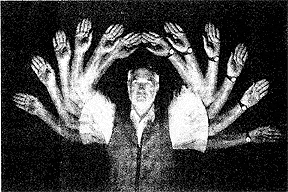|
reprinted from: Lehigh Valley Edition, The Express-Times, Sunday, July 6, 2003 SEEING ISN'T BELIEVING AT EXHIBIT
Photographer Andrew Davidhazy poses at the Discovery Center of Science
and Technology in South Side Bethlehem. Davidhazy is one of the architects
of the center's summer exhibit, "You Won't BelieveYour Eyes," which makes
science fun for' kids and adults.
Show at Discovery Center amazes kids and adults.
The entrance looks like a modern art museum. A picture of a bullet slices through an apple. A young girl sprays millions of germs into the atmosphere' with a single sneeze. Inside, the racket of a dozen metal balls, twirling and swirling on metal posts, echoes throughout the room. The summer exhibit, "You Won't Believe Your Eyes," is now on display at the Discovery Center on Third Street in South Side Bethlehem. The traveling exhibit joins more than 150 permanent exhibits on display at the center and will remain open until Sept. 9. Among the 12 stations in the exhibit are a kaleidoscope camera that projects funny faces to a television monitor, sound-activated magnets that "dance" and a machine that projects an image of a raindrop in freefall. And on one side of the room are almost two dozen photographs by scientific photographer Andrew Davidhazy. He and engineer Roger Soontag contributed to the spectacle. Discovery Center director Carol Woodley said the exhibit has amazed children and adults alike. Sonntag's "Friendly Technology" exhibit invites children to play with science. The nontraditional technique has people mesmerized, Woodley said. "I would like to say that we created this exhibit for scientists of all ages," Woodley said. "We have had some families come inhere for almost four hours. For only $2 it's a great activity for the family." Exhibit director Gary Kline is more than pleased with the reactions that he has been getting from children. He said he is happy with the exhibit because it is a fun way for kids to get interested in Science. "What we want to do is to get kids asking why," Kline said." c "What we would like to do with these exhibits is to give them answers to their questions and get them to ask their own." One exclamation Kline said he has heard children say over and over again is, "How did they do that?" That question inspired the title of the exhibit and was the same question that led Davidhay to become interested in scientific photography. "There was a side, of me that said: "I want to know how things work,"' Davidhazy said. "I wanted to wow my friends and one of the first things that I did was to make fake pictures of UFOs by combining two negatives. And I realized very early on that if you understood photography that you could use it to understand other things better." There was no opportunity to study scientific photography when Davidhazy attended college. The Rochester Institute of Technology, where Davidhazy is a professor of photography, is one of only several institutions in the entire world where students can learn the trade. "Much of what we know comes from what we see, and that is where photography comes in," Davidhazy said. "This is where a camera becomes a tool of science. If photography had not been invented, science would not be where it is today. Most people only think of photography in the artistic sense, My theory is that photography can be utilitarian and artistic, too." "People ask me, Wow, how did you do that?"' Davidhazy said. "Then when I tell them how, they say to me, Wow, that's really interesting!" It is the same reaction Davidhazy and Sonntag hope children will have when they visit the exhibit. Sonntag's exhibit has been on display at three locations prior to the Discovery Center. He has been creating exhibits for children since 1''". Sonntag has been in the business of creating since he was a child. As a son of a carpenter, he said he was amazed at the process of constructing large structures. He said he realized over the course of his career as an engineer that envisioning structures was just another form of creating a work of art. "There is a wonderful and purposeful experience when you combine science and art," Sonntag said. "In that process you can realize how much fun it is to make things work." Sonntag said he has found a real sense of fulfillment in bringing science to children's lives. He said when he builds his exhibits' he likes to use as many senses as possible to engage young museumgoers. According to Soontag most of his creations focus on children from 5 year olds to teens, but Woodley will argue that his exhibits can also draw a much older audience. But the real satisfaction for Sountag comes when he sees children formulating their own ideas about how things work. "Most of these experiments can be done at home with just a little bit of preparation," Sonntag said, "and I hope that they will go home and continue to experience it." What children don't realize, Sonotag said, is exhibits like his help kids focus on what they are interested in. He said his exhibits can he a step for a young child to create a vision for his or her own life. "You remember things like this," Sonntag said. "My hope is that when
these kids get older and they start to realize what it is that they really
want to do with their lives, they remember those dancing magnets and say:
Hey, that was really fun."'
or here! to send mail to Andrew Davidhazy (me!) |
